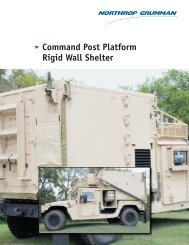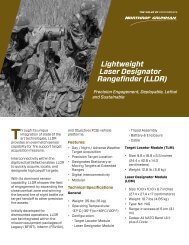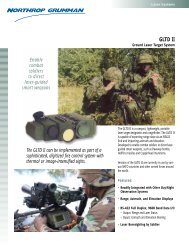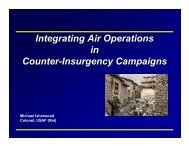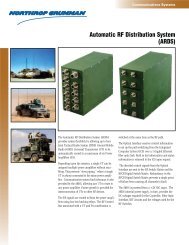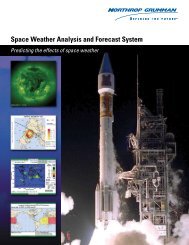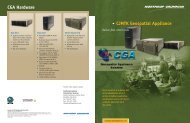AWACS Surveillance Radar - Northrop Grumman Corporation
AWACS Surveillance Radar - Northrop Grumman Corporation
AWACS Surveillance Radar - Northrop Grumman Corporation
Create successful ePaper yourself
Turn your PDF publications into a flip-book with our unique Google optimized e-Paper software.
<strong>Surveillance</strong> Systems<br />
<strong>AWACS</strong> <strong>Surveillance</strong> <strong>Radar</strong><br />
The Eyes of the Eagle
<strong>AWACS</strong> <strong>Surveillance</strong> <strong>Radar</strong>
A Heritage of Leadership<br />
The E-3 Sentry is an Airborne Warning<br />
and Control System (<strong>AWACS</strong>) aircraft<br />
that provides all-weather surveillance,<br />
Command, Control and Communications<br />
needed by commanders of air tactical<br />
forces. Proven in wartime operations such<br />
as Desert Storm, Allied Force and more<br />
recently Enduring Freedom, as well as<br />
ongoing peacekeeping and humanitarian<br />
efforts, <strong>AWACS</strong> is the premier air battle<br />
command and control aircraft in the<br />
world today.<br />
<strong>Northrop</strong> <strong>Grumman</strong> Electronic Systems<br />
(ES) has a long heritage in the<br />
development and production of Airborne<br />
Early Warning (AEW) radars. As the<br />
supplier to Boeing for the AN/APY-1 and<br />
AN/APY-2 radar systems used on the E-3,<br />
and the AN/APY-2 radar system used on<br />
the E-767, ES has continued as a leader in<br />
the development of radar technology for<br />
airborne applications.<br />
Mounted atop the aircraft fuselage in<br />
a rotating dome, the <strong>AWACS</strong> S-band<br />
(E-F band) surveillance radar is able to<br />
survey, in 10-second intervals, a volume of<br />
airspace covering more than 200,000<br />
square miles (500,000 square km) around<br />
the <strong>AWACS</strong>, or greater than 250 miles<br />
(400 km) in all directions. The radar uses<br />
a high Pulse Repetition Frequency (PRF)<br />
pulse Doppler waveform to distinguish<br />
aircraft targets from clutter returns. The<br />
ultra low sidelobe antenna is an important<br />
element of technology used to obtain<br />
performance over all terrains including<br />
urban and mountainous areas. The<br />
mechanical rotation of the rotodome<br />
scans the antenna beam through 360<br />
degrees of azimuth to cover targets in all<br />
directions. Electronic scanning of the<br />
antenna beam in elevation is used for<br />
measuring target altitude and for<br />
E-3 <strong>AWACS</strong>: The world leader in airborne surveillance, proven in times of war and peace<br />
stabilization of the beam for proper spatial<br />
coverage as the aircraft maneuvers.<br />
The first production <strong>AWACS</strong> system on<br />
a modified Boeing 707 aircraft was<br />
delivered in 1977. This system is now in<br />
service with the U.S. Air Force, the North<br />
Atlantic Treaty Organization (NATO),<br />
Saudi Arabia, the United Kingdom and<br />
the French Republic. The first 767 <strong>AWACS</strong><br />
configuration was delivered to Japan in<br />
1998 by the Boeing/<strong>Northrop</strong> <strong>Grumman</strong><br />
team. Combining the modernized,<br />
battle-proven <strong>AWACS</strong> mission system<br />
with a state-of-the-art aircraft ensures<br />
the ability of the <strong>AWACS</strong> system to defend<br />
the skies well into the 21st century.<br />
In order to counter today’s increasing<br />
threat sophistication, the <strong>AWACS</strong> radar has<br />
been significantly upgraded under the<br />
<strong>Radar</strong> System Improvement Program<br />
(RSIP). The RSIP modifications enhance<br />
radar performance characteristics, add new<br />
capabilities, improve the user interface,<br />
and lower the life-cycle cost of the <strong>AWACS</strong><br />
radar, while improving reliability.<br />
<strong>Northrop</strong> <strong>Grumman</strong> is committed to<br />
making the best even better, and to<br />
maintaining superior <strong>AWACS</strong> performance<br />
against tomorrow’s evolving threats.<br />
Modernization will ensure that the<br />
investments that made <strong>AWACS</strong> a reality<br />
will continue to provide returns for<br />
decades to come.
A Proven Force Multiplier<br />
Historically, military planners have found<br />
situational awareness of potential hostile<br />
targets and of friendly forces to be a key<br />
component in obtaining and sustaining<br />
military superiority over adversaries. Over<br />
the years radar has proven to be the<br />
optimum technology for obtaining long<br />
range, all-weather surveillance capability.<br />
An airborne surveillance radar that can<br />
maintain situational awareness of potential<br />
targets and friendly aircraft over hundreds<br />
of square miles of airspace in any direction<br />
became a reality with the introduction of<br />
the <strong>AWACS</strong>. One cannot overstate the<br />
importance of <strong>AWACS</strong> to the security and<br />
stability of the Free World. The weapon<br />
system acts as a force multiplier, greatly<br />
E-3 <strong>AWACS</strong> – The Air Warfare advantage<br />
E-3 <strong>AWACS</strong> – A critical element of coalition operations<br />
increasing the effectiveness of friendly<br />
forces performing a variety of missions.<br />
In armed conflicts and in peace keeping<br />
operations, in offensive and in defensive<br />
missions, <strong>AWACS</strong> is often the first in and the<br />
last out, providing essential <strong>Surveillance</strong>,<br />
Command and Control capabilities<br />
throughout the duration of the operation.<br />
During the Cold War, E-3 Sentries<br />
maintained constant vigil in the skies<br />
over Central Europe and the Far East.<br />
E-3 Sentry aircraft were among the first to<br />
deploy during Operation Desert Shield<br />
where they immediately established an<br />
around-the-clock radar screen. During<br />
Desert Storm, <strong>AWACS</strong> flew more than 400<br />
missions and logged more than 5,000<br />
hours of on-station time, providing<br />
radar surveillance and control for more<br />
than 120,000 coalition sorties. In addition<br />
to providing senior leadership with<br />
time-critical information on the actions<br />
of enemy forces, E-3 controllers assisted<br />
in 38 of the 40 air-to-air kills recorded<br />
during the conflict. Following Desert Storm,<br />
<strong>AWACS</strong> remained vigilant in Southwest Asia<br />
as a critical element of Operation Northern<br />
Watch enforcing U.N. Security Council<br />
resolutions.<br />
During the Balkans campaign, <strong>AWACS</strong><br />
was the controlling element of allied<br />
airpower. In Operation Allied Force, the E-3<br />
Sentries logged 4,800 flight hours on 500<br />
missions, in which they were responsible<br />
for coordinating and tracking offensive<br />
and defensive missions, searching for<br />
enemy aircraft and assuring safe<br />
separation of inbound and exiting<br />
aircraft. In addition, <strong>AWACS</strong> directed the<br />
refueling efforts of about 30 tankers<br />
orbiting over the Adriatic and provided<br />
initial search and rescue coordination.<br />
In October 2001, history was made as the<br />
NATO alliance for the first time ever aided<br />
the U.S. in homeland defense. NATO<br />
deployed five of its E-3 Sentry Airborne<br />
Warning and Control System aircraft from<br />
Geilenkirchen, Germany to help the 552nd<br />
Air Control Wing with Operation Noble<br />
Eagle, the defense of the United States.<br />
<strong>AWACS</strong> has been an operational asset<br />
since 1977 and is projected to be in service<br />
beyond 2035. For “The High Demand,<br />
Low Density” <strong>AWACS</strong> fleet to withstand<br />
tomorrow’s challenges, <strong>AWACS</strong>’s mission<br />
effectiveness must be enhanced through<br />
modernization and sustainment programs.<br />
The <strong>Radar</strong> System Improvement Program<br />
(RSIP) is one of many modernization<br />
programs that will ensure <strong>AWACS</strong>’s ability<br />
to continue keeping the skies safe in both<br />
war and in peace.
RSIP: Sharpening the Eye of the Eagle<br />
The <strong>Radar</strong> System Improvement Program<br />
(RSIP) provides the most significant<br />
upgrade to the <strong>AWACS</strong> radar since its<br />
development in the early 1970s. RSIP<br />
enhances the operational capability of the<br />
<strong>AWACS</strong> radar against the growing threats<br />
posed by smaller targets, cruise missiles,<br />
and electronic countermeasures.<br />
Battle-proven in all operations since<br />
Kosovo, RSIP has demonstrated excellent<br />
performance and reliability.<br />
RSIP introduces advanced pulse Doppler<br />
waveforms, pulse compression, and new<br />
processing algorithms implemented by<br />
hardware and software improvements that<br />
allow the system to detect and track<br />
targets at up to twice the range of the<br />
original <strong>AWACS</strong>.<br />
The improvement in detection performance<br />
is accompanied by impressive improvements<br />
in range and angular resolution. Range<br />
resolution is increased by up to 6 to 1, and<br />
azimuth and elevation accuracy by up<br />
to 2 to 1.<br />
The radar’s ability to respond to electronic<br />
attack is significantly improved as well.<br />
This improvement is the result of<br />
incorporating the latest technology in<br />
clutter rejection, processing, and man<br />
machine interface (MMI).<br />
The reliability and maintainability of the<br />
RSIP-enhanced <strong>AWACS</strong> is improved to<br />
increase radar availability and reduce<br />
repair time.<br />
RSIP provides multiple radar modes to<br />
allow for operational flexibility. Some of<br />
these modes are described below.<br />
H<br />
S<br />
T H E<br />
A<br />
R<br />
E Y E<br />
O<br />
P<br />
RSIP<br />
F<br />
E<br />
N<br />
T H E<br />
I<br />
N<br />
G<br />
E A G L E<br />
Multi-mode <strong>Radar</strong>: Flexibility to Watch the Skies<br />
Pulse Doppler Nonelevation<br />
Scan (PDNES)<br />
The PDNES mode provides surveillance of<br />
aircraft down to the surface by using pulse<br />
Doppler radar, with Doppler filters and a<br />
sharply defined antenna beam.<br />
Beyond-the-Horizon (BTH)<br />
The BTH mode uses pulse radar – without<br />
Doppler – for extended range surveillance<br />
where ground clutter is in the<br />
horizon shadow.<br />
Interleaved<br />
PDES and BTH can be used simultaneously<br />
with either portion active or passive. PDNES<br />
can be used simultaneously with maritime.<br />
PDNES MODE<br />
BTH MODE<br />
PDES/BTH<br />
INTERLEAVED MODE<br />
Pulse Doppler Elevation<br />
Scan (PDES)<br />
<strong>Radar</strong> operation in the PDES mode is<br />
similar to PDNES, but target elevation<br />
is derived by an electronic vertical<br />
scan of the beam.<br />
Maritime<br />
A very short pulse is used to decrease the<br />
sea clutter patch for detection of large and<br />
small surface ships in various sea states.<br />
An adaptive digital processor automatically<br />
adjusts to variations in sea clutter and<br />
blanks land returns by means of stored<br />
maps of land areas.<br />
Passive<br />
The radar transmitter can be shut down<br />
in selected subsectors while the receivers<br />
continue to receive and process data. This<br />
is an effective feature in a jammed (ECM)<br />
environment. A single accurate line<br />
(strobe) passing through the location<br />
of each jammer is generated on the<br />
display console.<br />
PDES MODE<br />
MARITIME MODE<br />
PASSIVE MODE
Designed for Performance<br />
The <strong>AWACS</strong> surveillance radar components consist of multiple units grouped<br />
in three locations. The antenna array and its electronics are in the rotodome.<br />
The receivers, radar processors, and radar control & maintenance panel are<br />
in the main cabin. The cabin equipment consists of two cabinets for the<br />
AN/APY-1 radar (digital and analog), and three cabinets (digital, analog<br />
and maritime) for the AN/APY-2. The transmitter group is in the lower lobe<br />
of the fuselage in the aft cargo bay.<br />
Antenna Array<br />
• 26' (8m) x 4.5' (1.3m) Ultra-Low Sidelobe Array<br />
• Stacked array of 28 slotted waveguides<br />
• Reflectionless transmit and receive manifolds<br />
• 28 reciprocal ferrite beam steering<br />
phase shifters<br />
• 28 low-power nonreciprocal beam offset<br />
phase shifters<br />
<strong>Radar</strong> Control and Maintenance Panel (RCMP)<br />
• Two CRT displays, keyboard and trackball<br />
• Spectrum analyzer<br />
• Easily removable power supplies<br />
• English language textual displays<br />
• PPI (Plan Position Indicator) display for<br />
radar performance assessment<br />
• FFT (Fast Fourier Transform) display<br />
<strong>Surveillance</strong> <strong>Radar</strong> Computer (SRC)<br />
• Adaptive Signal Processor (ASP)<br />
• 24-bit precision<br />
• 5 MHz data rate<br />
• Performs over 23 billion operations<br />
per second<br />
• Design consists of 74 multilayered printed<br />
circuit boards of 12 types<br />
• Designed with 534 real pipelined arithmetic unit<br />
gate arrays (RPLAU) operating at 20 MHz<br />
• Flexible design with full redundancy and<br />
preplanned growth capability<br />
• <strong>Radar</strong> Interface Adapter Unit<br />
(RIAU)<br />
• Dual Redundant input/output hardware<br />
• <strong>Radar</strong> Data Processor (RDP)<br />
• Dual VME bus-based 32-bit architecture<br />
• Four active processors plus one redundant<br />
processor; six input/output boards of four types<br />
• Each processor is a single module designed<br />
around a R4400 RISC CPU with 8 megabytes program<br />
memory plus instruction and data cache<br />
• Ada ® programmable<br />
• Accommodates up to four additional processors<br />
for growth<br />
Analog Cabinet<br />
• Analog Receiver<br />
• RF Assembly with redundant mixer preamplifier<br />
• Three Pulse Doppler IF (Intermediate Frequency)<br />
assemblies<br />
• PD A/D assembly with 15 bit, 5 MHz A/D converter<br />
• Three BTH IF assemblies<br />
• BTH A/D and processor assembly<br />
• Delay line pulse compression circuits for BTH<br />
• Clutter Tracker (6 circuit boards of 4 styles)<br />
• Synchronizer<br />
• 29 circuit boards of 18 types<br />
• Full redundancy<br />
• STALO<br />
• Four RF assemblies<br />
• Eight oscillator modules<br />
• Two up-conversion modules<br />
• Acoustic enclosure for isolation and stability<br />
• Phase Lock Loop (PLL) electronics
Phase Control Electronics<br />
• Phase Shifter Control Unit<br />
• Beam angle control circuits<br />
• Antenna tune data storage<br />
• Phase Shifter Drive Unit<br />
• 30 phase shifter current drive modules, two<br />
of which are redundant<br />
• Rotary Coupler (not illustrated)<br />
• One high-power channel for transmission,<br />
seven coaxial RF channels<br />
• 105 slip rings (16 for 400 Hz power, 89 for<br />
radar and nonradar signal paths)<br />
• Microwave Receiver<br />
• Three channels, one of which is redundant<br />
• Each channel contains a receiver protector<br />
(RP) and a Low-Noise Amplifier (LNA)<br />
• RP has five stages to protect LNAs at various<br />
power levels; completely passive operation<br />
• High Electron Mobility Transistor (HEMT)<br />
LNAs provide low noise figure for maximum<br />
signal-to-noise reception of target signals<br />
Transmitter Group<br />
• Transmit Electronics<br />
• Predriver: 2 redundant solid-state low<br />
power amplifiers, 2 watts minimum peak<br />
power each<br />
• Transmit Angle Control (TAC): 2 redundant<br />
digitally controlled attenuators<br />
• Driver: 2 redundant medium power<br />
amplifiers<br />
• Klystron Power Amplifiers (KPAs)<br />
• Two high power KPAs, two pulsers and grid<br />
pulser circuits<br />
• Pulser excursion: 1,000 V to +3,100 V<br />
Maritime Cabinet<br />
• Maritime Receiver<br />
• Delay line pulse compressor, sensitivity time<br />
control circuits, envelope detector, CFAR<br />
circuits, A/D converter, microprocessor<br />
• Five Intermediate Frequency (IF) assemblies<br />
• Digital Land Mass Blanker (DLMB)<br />
• Map storage memory, microcontroller<br />
• Digital control circuits<br />
• High Voltage Power Supply<br />
• SF 6 -pressurized units to reduce size<br />
and weight<br />
• 90 kV transformer, filter, and regulators<br />
• Comprises 5 of 21 major transmitter units<br />
• Auxiliary Units<br />
• Protection sensors; power distribution and<br />
control circuits<br />
• Comprises 10 of 21 major transmitter units<br />
• Added filter for improved stability
Engineered for Excellence<br />
Excellence in design, engineering and<br />
manufacturing have created this<br />
sophisticated and powerful radar system.<br />
The functional subsystems that comprise<br />
the radar are described here and<br />
numerically correlated with the block<br />
diagram on the facing page.<br />
1 Transmitter<br />
• Transmit Electronics<br />
• Predrivers – initial amplification of the signal from<br />
the STALO.<br />
• Transmit angle control (TAC) – controls transmitted<br />
power vs. elevation angle.<br />
• Drivers – intermediate power amplification.<br />
• Pulser – provides pulses to KPA.<br />
• Klystron Power Amplifiers (KPAs) – amplify and<br />
pulse-modulate RF signals; provide high peak power<br />
output over bandwidth.<br />
• HV Power Supply<br />
• Converts input prime power into filtered high<br />
voltage power.<br />
• Auxiliary Units<br />
• Distribute power to units and subassemblies.<br />
• Provide protection for high voltage components<br />
and circuits.<br />
• Control interrelated operation of 21 major units.<br />
2 Array and Rotodome<br />
Equipment<br />
• Antenna Array<br />
• The antenna, composed of slotted waveguide<br />
radiators, provides a narrow beam with low<br />
sidelobes through amplitude tapering.<br />
• Transmit Manifold<br />
• Accepts transmitter RF output and delivers it to<br />
28 amplitude-weighted radiating waveguides.<br />
• Receive Manifold<br />
• Accepts inputs from the 28 beam offset phase shifters,<br />
combines the signals in a power divider, and delivers<br />
the resultant signal to the microwave receiver.<br />
• Beam Steering Phase Shifters<br />
• Provide proper phasing of transmitted signals for<br />
low sidelobes.<br />
• Provide phase shifts to 28 radiating elements for<br />
vertical beam scanning.<br />
• Outputs of Beam Steering phase shifters on receive<br />
are delivered to the beam offset phase shifters.<br />
• Beam Offset Phase Shifters<br />
• Provide offset of receive beam from transmit beam<br />
during elevation scanning to compensate for time<br />
delay between transmit and receive of long-range<br />
aircraft returns.<br />
• Provide space coincidence of receive and transmit<br />
beams in nonscanning modes.<br />
• Phase Shifter Control Unit (PSCU)<br />
• Accepts commands from the radar computer to<br />
stabilize or scan the beam.<br />
• Accepts commands to select appropriate scan rate or<br />
squint angle.<br />
• Phase Shifter Drive Unit (PSDU)<br />
• Provides currents to drive beam steering phase<br />
shifters for beam stabilization and scanning and<br />
currents to drive beam offset phase shifters.<br />
• Microwave Receiver<br />
• Provides low-noise amplification of received signals.<br />
• Provides receiver from high RF power of radar<br />
transmitter output or other sources.<br />
• Rotary Coupler<br />
• Provides the coupling of the RF and other signals<br />
into and from the rotating rotodome.<br />
3 Analog Cabinet<br />
• Analog Receiver<br />
• Separates and routes Pulse Doppler (PD),<br />
Beyond-The-Horizon (BTH), and Maritime into<br />
separate receiver channels.<br />
• Coherently detects PD signals in in-phase and<br />
quadrature channels.<br />
• Provides clutter tracking for Pulse Doppler operation.<br />
• Range gates PD signals and converts from analog<br />
to digital format; forwards to adaptive signal<br />
processor (ASP).<br />
• Compresses, detects, and applies Constant False<br />
Alarm Rate (CFAR) to BTH pulses.<br />
• Converts BTH data to digital format and outputs to<br />
<strong>Radar</strong> Interface Adapter Unit (RIAU).<br />
• <strong>Radar</strong> Synchronizer<br />
• Generates all timing signals to operate the radar.<br />
• Provides software-controlled, selectable pulse<br />
repetition frequencies (PRFs).<br />
• Stable Local Oscillator (STALO)<br />
• Generates extremely stable radio frequency (RF)<br />
signals for radar transmission and signal conversion<br />
for detention processing.<br />
• Provides basic clock for radar operation.<br />
• Generates linear and non-linear FM signals.<br />
4 Maritime Cabinet<br />
(AN/APY-2 only)<br />
• Compresses, envelope detects, and converts maritime<br />
analog signal to digital data.<br />
• Sets detection criteria based on CFAR optimized<br />
for sea clutter.<br />
• Outputs maritime data in digital format to RIAU.<br />
• Digital Land Mass Blanker (DLMB) prevents land<br />
returns from interfering with processing of maritime<br />
returns by use of stored digitized land maps.<br />
5 <strong>Surveillance</strong> <strong>Radar</strong><br />
Computer (SRC)<br />
• <strong>Radar</strong> Interface Adapter Unit (RIAU)<br />
• Interfaces the RDP to the ASP, RCMP and other<br />
radar units, the E-3 central computer, and<br />
instrumentation equipment through specialized<br />
input/output hardware.<br />
• Includes two standard IEEE-488 interfaces to<br />
the RCMP.<br />
• Adaptive Signal Processor (ASP)<br />
• Performs digital pulse compression.<br />
• Notches out mainbeam clutter signals for<br />
Pulse Doppler (PD) modes.<br />
• Scans matrixed data and compares with dynamic<br />
thresholds for CFAR detection of signals.<br />
• Outputs digital detection data to the <strong>Radar</strong> Data<br />
Processor (RDP).<br />
• <strong>Radar</strong> Data Processor (RDP)<br />
• Accepts commands and input from central mission<br />
computer and RCMP via the RIAU.<br />
• Receives and processes target data from the ASP,<br />
analog receiver, and maritime processor via<br />
the RIAU.<br />
• Provides target and equipment status data to E-3<br />
central computer and RCMP via the RIAU.<br />
• Controls all radar internal operations including<br />
radar built-in test/fault isolation test (BIT/FIT).<br />
• Controls RCMP user interface.<br />
• Provides record/playback of radar data.<br />
6 <strong>Radar</strong> Control and<br />
Maintenance Panel (RCMP)<br />
• Turns radar on and off.<br />
• Displays status and maintenance data.<br />
• Controls radar during maintenance operation.<br />
• Provides technician interface during maintenance<br />
testing and manual fault isolation.<br />
• Has spectrum analyzer for ECCM features and<br />
special testing.<br />
• Provides Fast Fourier Transform (FFT) and<br />
Plan Position Indicator (PPI) display.
<strong>Radar</strong> Block Diagram<br />
Rotodome<br />
Receive<br />
Manifolds<br />
Microwave<br />
Receiver<br />
Phase<br />
Control<br />
Electronics<br />
(PSDU &<br />
PSCU)<br />
Beam Offset<br />
Phase<br />
Shifters<br />
Beam<br />
Steering<br />
Phase<br />
Shifters<br />
Antenna<br />
Array<br />
2<br />
Rotary<br />
Coupler<br />
Transmit<br />
Manifold<br />
4<br />
Maritime Cabinet E-32<br />
DLMB<br />
MSC<br />
Receiver<br />
P91 Console<br />
RCMP<br />
6<br />
Analog Receiver<br />
RF<br />
Ass'y<br />
BTH<br />
Receiver<br />
<strong>Radar</strong> Interface<br />
Adapter Unit (RIAU)<br />
Command &<br />
Navigational<br />
Data<br />
Mission<br />
Computing<br />
PD<br />
Receiver<br />
Clutter<br />
Tracker<br />
Adaptive Signal<br />
Processor<br />
(ASP)<br />
Target<br />
Reports<br />
& <strong>Radar</strong><br />
Status<br />
3<br />
STALO<br />
Synch.<br />
timing<br />
Analog (E-26) Cabinet<br />
<strong>Radar</strong> Data<br />
Processor<br />
(RDP)<br />
Digital (E-25) Cabinet<br />
5<br />
Klystron<br />
Power<br />
Amplifier<br />
Pulser<br />
Aux<br />
Units<br />
HVPS<br />
Klystron<br />
Power<br />
Amplifier<br />
Pulser<br />
1<br />
Driver<br />
Driver<br />
TAC<br />
Predriver<br />
Predriver<br />
Transmitter – Lower Lobe<br />
Legend<br />
Transmit path<br />
Receiver path<br />
High Voltage<br />
Control and<br />
Digital Signals
Built for Reliability<br />
Our expertise allows us to reach outstanding service benchmarks and keeps the aircraft operational<br />
<strong>Radar</strong> system reliability and sustainability<br />
improvements are key to improving the<br />
availability and force-multiplying effects<br />
of <strong>AWACS</strong>. To ensure these improvements<br />
are rapidly incorporated into the radar<br />
system, <strong>Northrop</strong> <strong>Grumman</strong> Electronic<br />
Systems successfully merged design,<br />
manufacturing, and support capabilities<br />
into a world class <strong>Radar</strong> Support Center of<br />
Excellence (COE). The <strong>Radar</strong> Support<br />
Center of Excellence is a global network<br />
aimed at providing cost effective support<br />
and incremental system upgrades by<br />
inserting leading edge logistics and systems<br />
technologies. This coupled with the<br />
application of "best practices" enables the<br />
<strong>Radar</strong> Support Center of Excellence to<br />
efficiently handle all areas of logistics<br />
support while providing best value to<br />
the customer.<br />
Logistics Engineering Services<br />
The <strong>AWACS</strong> radar requires disciplined<br />
logistics planning and maintenance<br />
support to ensure effective day-to-day<br />
operations. <strong>Northrop</strong> <strong>Grumman</strong> Electronic<br />
Systems is experienced in supportability<br />
planning and can provide the strategic<br />
view essential for long term product<br />
sustainment. Our logistics engineers, design<br />
engineers, and field engineers collaborate<br />
to ensure that field data and customer<br />
feedback are considered throughout the<br />
planning and implementation process.<br />
This team applies advanced analysis and<br />
modeling techniques to ensure cost<br />
effective support.<br />
Depot Repair and Software<br />
Maintenance Services<br />
<strong>Northrop</strong> <strong>Grumman</strong> Electronic Systems<br />
has a full range of repair and software<br />
maintenance capabilities integrated with<br />
the factory and our regional support<br />
centers. These comprehensive, seamless<br />
capabilities allow us to address all customer<br />
repair needs and to cost effectively insert<br />
performance and reliability upgrades to<br />
system hardware and software.<br />
Field Engineering Services<br />
An integral part of <strong>AWACS</strong> radar support<br />
are the services and on-site consultations<br />
provided by our Field Engineers. Our Field<br />
Engineers are actively involved in system<br />
development, integration, installation and<br />
checkout, acceptance testing, consulting,<br />
and other services required by our<br />
domestic and international customers.<br />
They are experienced at dealing with all<br />
levels of hardware/software operations<br />
and maintenance.<br />
Technical Data and Advanced<br />
Diagnostic Systems<br />
<strong>Northrop</strong> <strong>Grumman</strong> Electronic Systems<br />
provides the necessary technical data and<br />
diagnostic systems required to properly<br />
maintain the AN/APY-1/2 radar systems.<br />
Operations/Maintenance manuals and<br />
software documentation can be delivered<br />
via print, electronic media, web based<br />
access or by embedding in mission or<br />
system test equipment. Also, advanced<br />
Standalone Diagnostic systems are<br />
available to enhance BIT/FIT diagnostics<br />
and analysis.<br />
Training<br />
The <strong>Radar</strong> Support Center of Excellence<br />
has the necessary tools and techniques to<br />
provide our customers with the proper<br />
training to operate and maintain the<br />
<strong>AWACS</strong> radar systems. Training engineers<br />
use simulations, scenarios and other<br />
techniques to teach theory, operations<br />
and maintenance.<br />
Support Chain Management<br />
<strong>Northrop</strong> <strong>Grumman</strong> Electronic Systems<br />
remains committed and capable of<br />
providing spare parts, assemblies and<br />
subsystems necessary to maintain the<br />
<strong>AWACS</strong> radar systems. Our eBusiness and<br />
Support Chain Management systems<br />
together with our innovative processes<br />
provide our customers with on-line part<br />
visibility and rapid resupply of spares<br />
and repairs.<br />
ES provides world-wide <strong>AWACS</strong> support
Moving into the Future<br />
21 st Century <strong>AWACS</strong> Requirements<br />
Better Performance<br />
Sustainment<br />
New Capabilities<br />
• Smaller Targets<br />
• Greater Range<br />
• Better Height Accuracy<br />
• Improved Track Quality<br />
• Lower Ownership Costs<br />
• Improved Reliability &<br />
Maintainability<br />
• Slower Targets<br />
• Helicopter Detection<br />
• High Speed Missiles<br />
• Frequency Diversity<br />
Improving <strong>Surveillance</strong> to Meet 21 st Century Needs<br />
The Airborne Early Warning and Control<br />
(AEW&C) capability that <strong>AWACS</strong> provides<br />
has become an indispensable element of<br />
modern air operations. The strategic and<br />
tactical value of <strong>AWACS</strong> has grown over<br />
the decades since its initial deployment in<br />
the late 1970s, and will continue well<br />
into the 21 st century.<br />
As the world changes, the roles and<br />
missions of <strong>AWACS</strong> evolve. 21 st century<br />
AEW&C missions are increasingly complex.<br />
In addition to its original AEW missions,<br />
<strong>AWACS</strong> is essential to a broad variety of<br />
operations, including Peace Support<br />
Operations, multi-national coalitions,<br />
air control, Homeland Defense,<br />
counter-narcotics, Combat Search and<br />
Rescue, and more.<br />
The complex mission environment<br />
includes an airspace filled with a broader<br />
variety of air vehicles than ever before,<br />
including friendly forces, hostile forces,<br />
neutral and commercial aircraft, UAVs,<br />
and unknowns. Threats have multiplied<br />
and become more advanced, requiring<br />
new capabilities to detect, track, and<br />
identify smaller targets, unmanned air<br />
vehicles, various missiles, and helicopters,<br />
in order to maintain situational awareness<br />
and ensure air superiority.<br />
The E-3 <strong>AWACS</strong> is considered the most<br />
capable airborne surveillance system in<br />
the world. It was designed to meet specific<br />
goals and has been optimized to perform<br />
its task extremely well. However, advances<br />
in technology have made further<br />
radar improvements possible. Future<br />
modifications will allow <strong>AWACS</strong> to adapt<br />
to evolving missions and threats.<br />
System upgrades are being studied or<br />
developed to provide:<br />
• Improved detection performance<br />
• Better track quality through processing<br />
techniques<br />
• Detection and tracking of an expanded<br />
variety of target types, including slow or<br />
maneuvering targets, helicopters, and<br />
high speed targets such as missiles<br />
• Greater frequency flexibility to<br />
operate effectively in the presence of<br />
electromagnetic interference<br />
• Improved user interface<br />
• Improved system reliability,<br />
maintainability, and availability (RMA)<br />
Modernization and sustainment will<br />
ensure that <strong>AWACS</strong> continues to protect the<br />
skies with confidence well into the future.
For more information, please contact:<br />
For more information, please contact:<br />
<strong>Northrop</strong> <strong>Grumman</strong> <strong>Corporation</strong><br />
Airborne <strong>Surveillance</strong> Systems<br />
P.O. Box 746, MS 805<br />
Baltimore, Maryland 21203 USA<br />
Phone: 1-800-443-9219<br />
International: 1-410-552-2455<br />
Fax: 1-410-765-2006<br />
E-mail: <strong>AWACS</strong>@ngc.com<br />
BR-034-TJD-0703


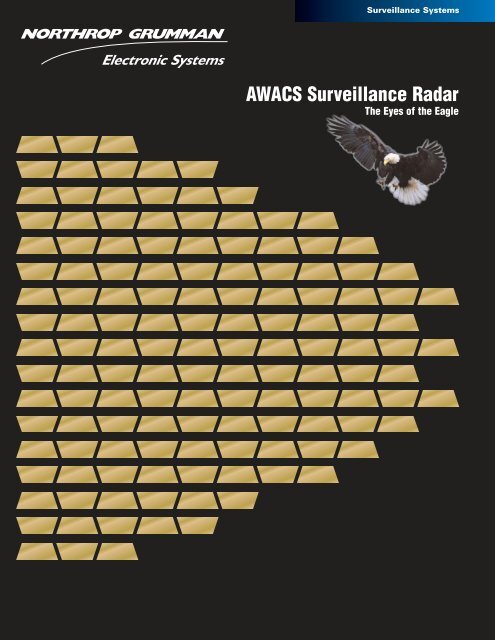
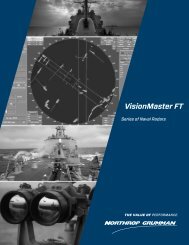
![[x] amendment of solicitation/modification of contract - Northrop ...](https://img.yumpu.com/51622731/1/190x245/x-amendment-of-solicitation-modification-of-contract-northrop-.jpg?quality=85)
